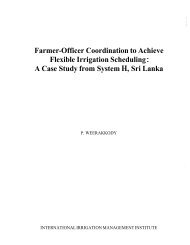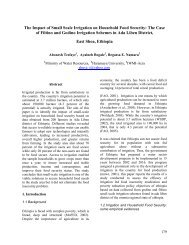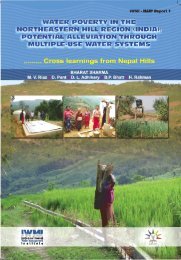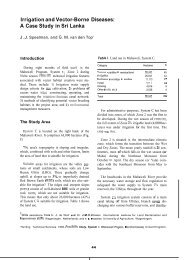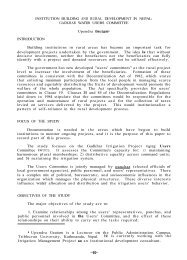S.G. Bhogle
S.G. Bhogle
S.G. Bhogle
- No tags were found...
You also want an ePaper? Increase the reach of your titles
YUMPU automatically turns print PDFs into web optimized ePapers that Google loves.
102<br />
g. Boosting agro-based industries (sugar factories, rice mills etc.);<br />
h. Water supply for drinking and industrial purposes;<br />
i. Improvement in infrastructure facilities;<br />
j. Increase in fisheries, trade, transport, tourism etc.<br />
However, proper and adequate documentation of benefits due to irrigation projects has<br />
not been done meticulously and seriously. On the contrary, the ill effects or hazards due to<br />
irrigation projects are given wide publicity through excellent documentation in print and<br />
electronic media. It is therefore necessary to identify the factors which are directly or<br />
indirectly responsible for poverty alleviation. With this idea in mind the following issues/<br />
questions for taking up research studies are suggested.<br />
1. Completion of irrigation project itself is one of the prime pro-poor interventions<br />
in irrigated agriculture in India. Systematic planning for the completion of<br />
ongoing irrigation projects and provision of adequate budget is the need of the<br />
time. If irrigation projects are completed on time, the most vital step of poverty<br />
alleviation is taken. Completing “project” (and not just civil works!) in the truest<br />
sense of the term without cost-and-time-overruns would be the most fundamental<br />
and crucial pro-poor intervention. Equity and increased productivity are just not<br />
possible in the following scenario, which has become common everywhere.<br />
“Incomplete project --> poor performance --> inequitable water distribution<br />
--> tail-end problem --> faulty system --> inability to implement any good idea<br />
--> 50-60 percent rainfed area in the irrigation command --> poverty<br />
with-and-within an irrigation project.”<br />
It is therefore necessary to take an in-depth performance evaluation studies<br />
of irrigation projects to start with on a sample basis. In all the agro-climatic zones<br />
of India, one major, one medium and one minor irrigation project should be<br />
evaluated by comparing the project objectives and if the objectives are not<br />
accomplished, the lessons learnt as feed back will be useful for the redesigning<br />
of the proposed irrigation projects.<br />
2. Developing user friendly canal systems with simple hardware and software<br />
(“KISS” principle—keep it simple and stupid!) that can be understood, operated<br />
and maintained mostly by the users themselves would be the second important<br />
pro-poor intervention. This is technically feasible with the following strategy.<br />
Software<br />
Hardware<br />
Location-specific<br />
- Ungated self-regulating outlets(SRO)<br />
various combinations of - Proportionate flow dividers(PFD)<br />
- Phad - Weirs (e.g., diagonal, duck-bill)<br />
- Warabandi - Hydro-mechanical gates(e.g., AVID, AVIS)<br />
- RWS - Night storages<br />
- Limited rate demand schedules - Balancing reservoirs



